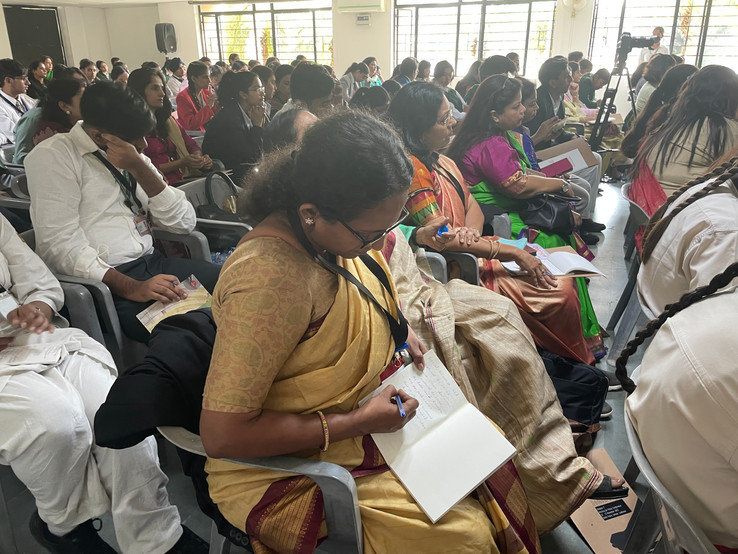
Carrying forward the torch of this year's annual conference in Calcutta, History for Peace, in association with Takshila Educational Society continued the theme of 'The Idea of Democracy' in Ludhiana this November. We conducted this conference for a combined audience of teachers and students. Here are glimpses of the event from the lenses of participants, both teachers and students.
We begin by sharing the compiled impressions of student-attendees from the Shiv Nadar School, Gurugram:
Aarunya, a student of Grade 10 believes that the conference produced a twofold effect on him, firstly the sheer awe of listening to these speakers and the way they presented their whole case; and secondly the actual substance of their arguments, which made explicit simple but crucial things in matters of history and democracy. Jai Mahanta adds that the two-day conference helped him consolidate his understanding of Governance, law and politics. The discussion with eminent scholars on issues of relevance exposed him to new ideologies and taught him the importance of resilience and value-based decisions.
Avani, a student of Grade 11 shared her reflections by stating that this conference was the most intellectually engaging conference she has ever been a part of. She is extremely grateful that she was given the opportunity to listen to renowned speakers and engage in workshops which helped deepen her understanding of democracy. What she learned here will always stick with her and she will be able to implement it in her daily life. Divija says, in addition to learning a lot about the concept of democracy, she also made friends and lifelong memories. The students were very grateful that their teachers and school gave them this opportunity.
Here's an excerpt from a report by Meera Bhuvanesh, a teacher from DPS, Coimbatore, where she shares one inspiring instance from the conference proceedings that she endeavoured to take into her classroom:
In the early afternoon the session by Ms Grace and Ms Neha was outstanding. The idea and initiation of the concept of social justice was exquisitely sketched—we could witness change in perceptions in the adults in the classroom. The goals of sustainable development were also reinforced.
Take Away to the Classroom: I was curious to see how the techniques used by the resource persons Ms Grace and Ms Neha works in a classroom of young minds. I was assigned a substitution class in grade VIII. I decided to experiment with the same activity conducted in the workshop. I must admit it worked brilliantly. A carton is kept at a distance and a few students are made to stand in three rows one behind the other and then asked to throw the ball from a distance into the carton. Obviously the row in the front is most privileged one and then we started a discussion with the rest of the students who are observing the whole activity. The responses received from 13 year-olds were thoughtful and the dialogue was meaningful.
Apoorvanand's talk left a rather strong impression on Aarunya, an attending student, who notes:
He starts off his speech by mentioning the relation history has with the people, how the whole of history is connected and how, despite people accepting history as they might like it, the whole history of the world is ours as it is, and for all the peoples of the world. This then leads into the main point of the speech: ‘hum saath mein rahenge’, the basic tenet of democracy. However, he goes on to break this question down with two simple thoughts: ‘ye “hum” kaun hain, aur ye hum kaha saath mein rahenge’. It was understanding the very scope and nature of this question and its answers that formed the majority of the substance of his speech. The former half of his question formed a very intriguing case: how democracy is a symbol of growing individuality; of the individual’s growing freedom and right to not be questioned; how does society codify its people amid such rising individuality and ‘how to keep people alike as humans but free as individuals?’—the balance that forms the basic question of democracy.
Divija, another student participant, shares her excited take on the 'Reimagining Media' workshop at the conference:
We attended a workshop conducted by Ms. Asmita Prabhakar that highlighted media literacy and its importance. It also focused on the spread of false information brought on by social media. In a world where we’re drowning in information, it is difficult to distinguish genuine news from false information. Through an activity, we discovered why so many people believe fake news. We also addressed the distinction between opinion editorials and biased news, and engaged in a related activity that helped us comprehend the fundamentals of fact-checking. The session came to a close with an explanation of the importance of words and journalism, particularly for student reporters. We learned how to spot fake news throughout this session, and as a result, we are more equipped as students to pay attention when we are reading news.























Comentários